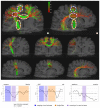Resolving bundle-specific intra-axonal T2 values within a voxel using diffusion-relaxation tract-based estimation
- PMID: 33301934
- PMCID: PMC7615251
- DOI: 10.1016/j.neuroimage.2020.117617
Resolving bundle-specific intra-axonal T2 values within a voxel using diffusion-relaxation tract-based estimation
Abstract
At the typical spatial resolution of MRI in the human brain, approximately 60-90% of voxels contain multiple fiber populations. Quantifying microstructural properties of distinct fiber populations within a voxel is therefore challenging but necessary. While progress has been made for diffusion and T1-relaxation properties, how to resolve intra-voxel T2 heterogeneity remains an open question. Here a novel framework, named COMMIT-T2, is proposed that uses tractography-based spatial regularization with diffusion-relaxometry data to estimate multiple intra-axonal T2 values within a voxel. Unlike previously-proposed voxel-based T2 estimation methods, which (when applied in white matter) implicitly assume just one fiber bundle in the voxel or the same T2 for all bundles in the voxel, COMMIT-T2 can recover specific T2 values for each unique fiber population passing through the voxel. In this approach, the number of recovered unique T2 values is not determined by a number of model parameters set a priori, but rather by the number of tractography-reconstructed streamlines passing through the voxel. Proof-of-concept is provided in silico and in vivo, including a demonstration that distinct tract-specific T2 profiles can be recovered even in the three-way crossing of the corpus callosum, arcuate fasciculus, and corticospinal tract. We demonstrate the favourable performance of COMMIT-T2 compared to that of voxelwise approaches for mapping intra-axonal T2 exploiting diffusion, including a direction-averaged method and AMICO-T2, a new extension to the previously-proposed Accelerated Microstructure Imaging via Convex Optimization (AMICO) framework.
Keywords: COMMIT; Diffusion MRI; Human brain; T(2) relaxometry; Tractography; White matter.
Copyright © 2020 The Authors. Published by Elsevier Inc. All rights reserved.
Figures







References
-
- Aboitiz F, Scheibel AB, Fisher RS, Zaidel E. Fiber composition of the human corpus callosum. Brain Res. 1992;598:143–153. - PubMed
-
- Barakovic M, Girard G, Romascano D, Rafael-Patino J, Descoteaux M, Innocenti GM, Jones DK, Thiran J-P, Daducci A. Assessing feasibility and reproducibility of a bundle-specific framework on in vivo axon diameter estimates at 300mT/m; Proceedings of the ISMRM; 2018.
Publication types
MeSH terms
Grants and funding
LinkOut - more resources
Full Text Sources
Other Literature Sources

